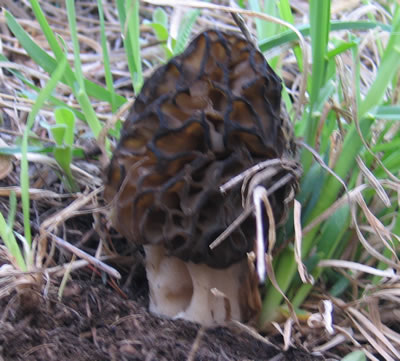Common AZ fungi in Ponderosa Forest
The vast majority of forested area in Arizona is arid woodland. At lower, hotter, dryer elevations are the vast Pinyon - Juniper forests. At higher, cooler, slightly wetter elevations are the Ponderosa forests. These forests lack a substantial humus layer, and retain moisture in their soils poorly. These are far from ideal conditions for mushroom producing fungi, but the conditions are just adequate enough for some of the more xeritolerant species to make a living.
Most of the fungi you will see in Ponderosa forests are in one of three categories:
- Mycorrhizal fungi that dwell in the deeper, more moist soil.
- Long lived wood rotters that grow slowly, expanding their boundries (and their fruiting bodies) a little after each rainy season.
- Fungi that incorporate dessication in their strategy set, such as puffballs and earthstars.
Slippery Jacks
- Suillus spp.
Slippery Jacks get their name from how slimy their cap cuticle becomes when wet. They are one of several genera that belong to the boletes (pored mushrooms). They are mycorrhizal, and associate with conifers almost exclusively. In Arizona, you rarely find other members of the boletes (such as the king bolete) in association with Ponderosa Pine. Most Slippery Jacks are edible, but are typically of poor quality. As a general rule, bitter Slippery Jacks are inedible.
Properties:
- Cap surface is slimy when wet
- The cap is almost always soft and spongy.
-
The stem is either smooth or ornamented with dots, but is never rough like Leccinum or reticulated like Boletus.
-
The cap and stem are typically a shade of yellow-brown.
- The pore layer is attatched to the stem.
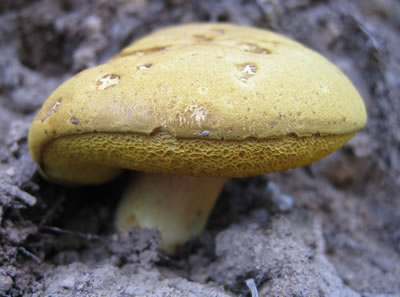
Barrow's Bolete
- Boletus barrowsii
Barrow's bolete is often referred to as a pure white cousin of the most prized king bolete, Boletus edulis. Its discovery is attributed to Chuck Barrows of New Mexico, an amateur mycologist and quite a character. I highly recommend that you read this article about Mr. Barrows and his bolete.
The Barrow's bolete is a prized edible bolete that only occurs in the Southwest within Ponderosa Pine edge habitat. That makes it a great candidate for mushroom road hunting! Although the BB is said to associate only with Ponderosa, I have found numerous fruitings in one location occupied exclusively by White Fir. Although the BB occurs with Ponderosa, it does so at the wettest regions of its range. Dry, sandy ponderosa stands are unlikely to support this wonderful mycorrhizal partner.
Properties:
- The Barrow's bolete is a cinch to identify...
- Gray-white cap, cream colored pores, pinkish stem
- As with all members of Boletus: a reticulated stem
- Pores do not grow into the stem (or do so slightly)
- Often very large, from tennis-ball size when immature to large grapefruit or larger when fully grown
- Occurs in proximity to Ponderosa Pine
- No staining reactions
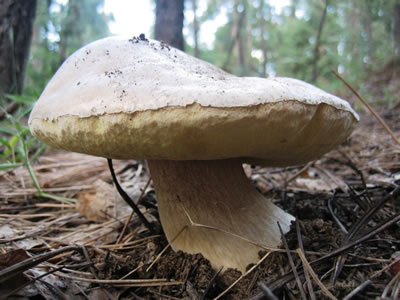
The beautiful and coveted Barrow's Bolete. The most abundant fruitings of this fungus tend to be on the edges of Ponderosa Pine stands that recieve decent rainfall. The most I have found have been along the Rim Road (FR300) during the monsoon season.
Russula spp. and Lactarius spp.
The genus Russula contains around 700 species, and are especially difficult to identify to species. They are mycorrhizal, and, in Arizona, associate almost exclusively with conifers. Both Russula, and its sister genus, Lactarius, have unique tissues that are brittle and crumbly instead of fibrous. This makes these genera easy to identify... but again, good luck narrowing them down to species!
Russula contains many edible species, and fortunately, in North America it is fairly easy to pick out inedible specimens. As a general rule, those members of Russula that have a peppery taste when raw are inedible / poisonous.
Properties:
- Often short, squat, with wide stems.
- Brittle flesh that crumbles in the hand. Stem snaps cleanly when broken.
- Inner flesh is almost always white. Cap color can vary greatly, however. Common colors are red, grey, and yellow.
- Gills almost always white or slightly yellow.
- If the mushroom matches the above criteria and bleeds when damaged, it is a Lactarius.
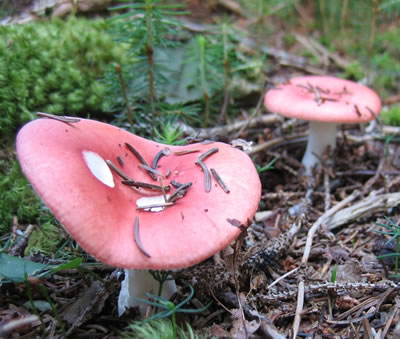
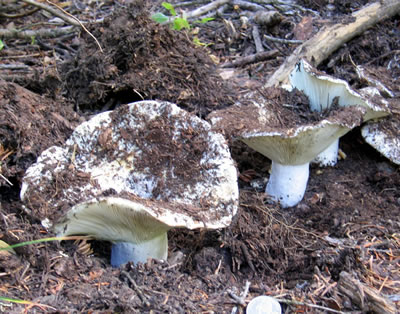
This photo is intentionally non-pristine. Russulas have a habit of developing fully before emerging from the humus. Often their caps will be covered with dirt / needle litter. Unemerged Russulas are often referred to as, "Mushrumps".
Earthstars
- Astreus spp. and Geastrum spp.
These specialized puffballs are great fun to discover. When immature, they look like little brown balls. As they mature, the star arms open along perforated seams, and fold back to form a stand that raises the puffball section off the ground. This speeds drying and increases the distance the spores will travel on a breeze. Interestingly, they rely on raindrops from a future rain to "knock out" the newly dried spores.
Unlike puffballs, which are detritus decomposers, earthstars are mycorrhizal. I have found them in rings surrounding Pine and Doug. Fir saplings.
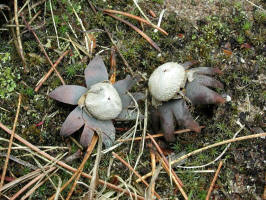
These particular earthstars, Geastrum hygrometricus, are especially fun to find and you should keep a few if you do. They are capable of repeatedly closing and opening as they are dried out and rewet.
Photo: perverdonk.com
Conks, brackets, and shelves
The Ponderosa forest is filled with wood rotters. Truly spectacular scenes of wood rotting can be found in the Rodeo Chedeski burn areas. Wood rotting fungi in the Ponderosa forest are a specialized lot, and require far less moisture (but far more time) than those in the mixed conifer areas. These are fungi that produce conks, brackets, shelves, and crust-like fruiting bodies.
Ganoderma spp. and Fomes spp. (Figure 1)
Ganoderma and Fomes are classical conk forming wood rotters. Their fruiting bodies are perennial, and can grow to gigantic size. I have found Ganodermas as large as a trash can lid. Each growing season, they will add a new layer of tissue, often forming visible growth rings like a clamshell. For Ganoderma, new tissue typically increases the conk diameter. For Fomes, the new layer is often on the underside, creating a hoof-shaped conk.
Trametes spp., Stereum spp., Gloeophyllum spp. (Figure 2)
Members of this wood rotting group form much smaller, thin fruiting bodies that are often referred to as brackets. But don't let their small size mislead you. These wood rotters are every bit as potent as their conk-forming relatives, and a large tree / log can be completely occupied inside despite the dimunitive structures showing outside.
There are a wide variety of bracket producing wood rotters. The three I am highlighting are the most common in each of three categories, based on their spore-bearing undersides.
- Trametes includes the well known Turkey-tail, so named for its colorful zonated fan-shaped brackets. The underside of Trametes contains tiny pores.
- Stereum comes in many shapes and shades, and it has a smooth underside.
- Gloeophyllum produces slightly cupped, fan shaped brackets. Its tissues are typically dark brown, and it has a gilled underside.
Cinnibar Red Polypore
- Pycnoporus cinnibarinus (Figure 3)
P. cinnibarinus is a spectacular reddish orange wood rotter that produces brackets that are much thicker than those mentioned above. When immature, the entire bracket is brilliantly colored. In a short time, however, sunlight bleaches the upper surface, leaving it pinkish-white with a trace of red on the outer margin. The pore surface underneath remains brightly colored, however. These brackets are perennial, but rarely grow larger than 4"-6" diameter.
I have personally only found P. cinnibarinus in the Pinyon-Juniper forests near Prescott and Sedona. It probably occurs throughout the arid forest regions, and is certainly worth keeping an eye out for wherever you are.
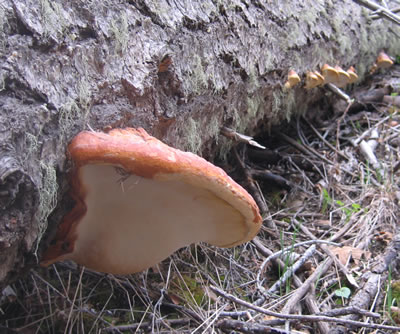
Figure 1: Giant Fomitopsis pinicola conks in the Rodeo Chedeski burn zone.
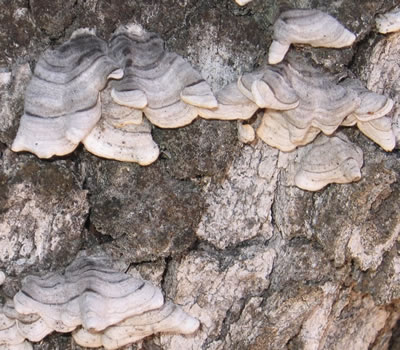
Figure 2: Stereum sp. on a standing dead trunk in another burn area.
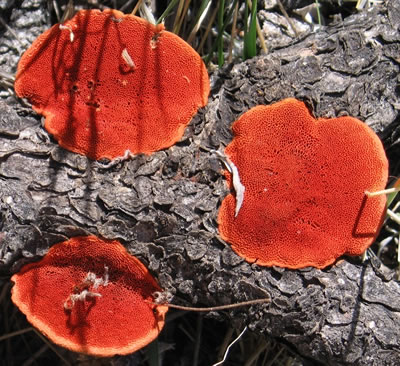
Figure 3: Pycnoporous cinnibarinus on a fallen Juniper branch, flipped over to show the spectacular pore surface.
Those giant shiny orange mushrooms!
Gymnopilus spectabilis
Spectabilis indeed! G. spectabilis grows such large, visible fruitings that it can be seen a football field away from the highway! This giant wood rotter often colonizes tree stumps, and can also be found at the base of standing dead (or dying) conifers.
It is hard to misidentify G. spectabilis, but in some cases rain and sun can diminish its powerful orange pigments. No Gymnopilus species is edible, but you would figure that out on your own if you tried nibbling on its incredibly bitter flesh.
Properties:
- Massive! Each individual mushroom can weigh several pounds and can be 12" in diameter.
- Orange surfaces and flesh. Shiny cap surface.
- Orange-brown sporeprint. Just handling a cap may leave your hands completely covered in orange powder.
- Most often at the base of a dead conifer.
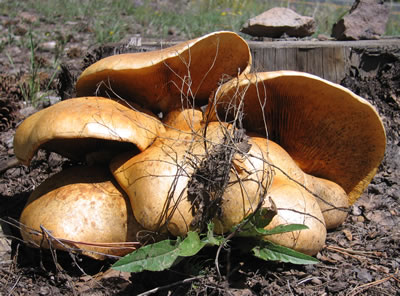
Massive fruitings can be seen along Highway 180 north of Flagstaff after the monsoon rains and well into the fall. This is where forest thinning has left numerous conifer stumps alongside the road, each colonized by various wood rotting fungi.
Caesar's Amanita
Amanita caesarea group
Few Amanitas can be found in the drier Ponderosa Forest regions of Arizona, but the edible Caesar's Amanita can appear in great numbers in certain places. A. caesarea is mycorrhizal with conifers (as are many Amanitas), and in Arizona may be exclusively so with Ponderosa. Caesar's Amanitas can grow to tremendous size, and are brilliantly colored. In later stages of maturity, they often become sunbleached, turning their caps a paler color but also enhancing their irridescence. Like the Gymnopilus above, mature Caesar's can be seen from far away.
There is good debate as to how closely related the North American Caesar is to the true A. caesarea from Europe. I personally believe that if the European Caesar's were the same as our local counterparts, it would never have become popular. The Caesar's that occur in Arizona are certainly edible, and many foragers collect them, but for me the flavor is metallic-fishy; not something that I want on my plate.
Note the major features in the photo: bright orange cap, gills, and skirt but with a white stem. This combination is strongly diagnostic; I have never encountered a different Amanita in Arizona (or elsewhere) with these features.
Properties:
- Bright orange cap, gills, and skirt when young
- Both skirt and volva present
- White stem.
- Striated cap margin
- Can grow to very large size
- Prefers forest edges
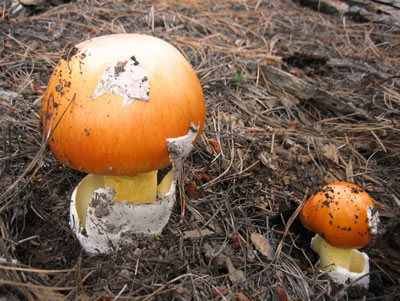
Caesar's Amanitas can be found in high numbers along Hwy. 260 east of Show Low, and along the Mogollon Rim Road FR300. They tend to prefer ponderosa forest edges rather than interiors.
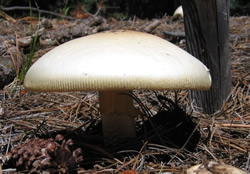
This is a sun-bleached older specimen. When in this state, they are visible for great distances and easily spotted from your vehicle.
Morels
- Morchella spp.
Morels are the most highly prized and sought after wild mushroom in America. However, if the rest of the US was like Arizona, they would probably be mostly overlooked. Our arid climate and mild winters often fail to satisfy the very strict fruiting requirements of morels. Morels go through a series of physical changes as the seasons pass, and require a cold winter and a lengthy, wet snowmelt in the spring for mushroom production. Fruitings typically appear 2-4 weeks following the snowmelt (so, late April to mid May). In Arizona and throughout the Colorado Plateau, the primary (or only) Morel is the Black Morel.
Arizona does have one condition in its favor: forest fires. Morels have a reputation for springing up in the spring after a previous year's forest fire. Of course, the common requirements of cold winter and snowmelt still stand. So, if you want to improve your chances of finding Morels, pay attention to Forest Service notices of controlled burns and other fires.
Beware the false Morel, Gyromitra. Be sure to visit the "Know Your Enemy" section to familiarize yourself with it.
